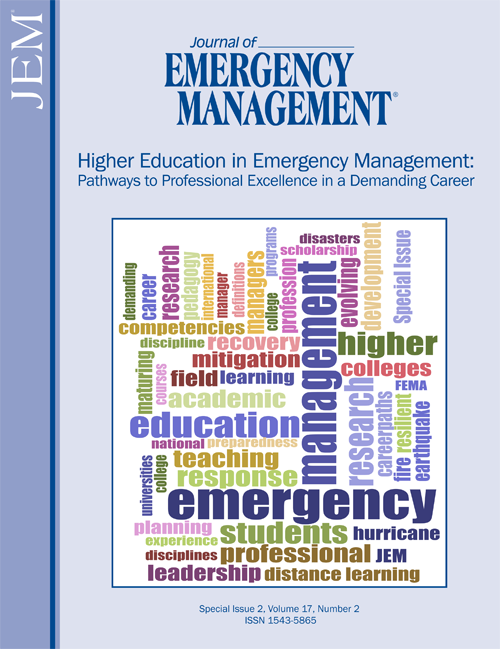Diversity in emergency management scholarship
DOI:
https://doi.org/10.5055/jem.2019.0407Keywords:
emergency management, diversity, women, race and ethnicity, higher education, disastersAbstract
Women and racial/ethnic minorities have long been underrepresented in the field of emergency management. This is true for both practice and research. The lack of women and racial/ethnic minorities in the profession and their perceived absence in research or scholarly study may have impacts on the effectiveness of response and recovery efforts as well as the broader scientific knowledge within the field. Historically, women and racial/ethnic minority communities have disproportionately experienced negative impacts following disasters. Earlier related studies have pointed to the underrepresentation as a contributing factor in community vulnerability. The scarcity of women in practice and as students in this field has been particularly evident in the United States. Using data from a recent survey of emergency management programs nationwide, this article reviews the concerns in research with regards to women and ethnic minority communities during disasters, efforts to increase representation of these groups in the field, and discusses the implications for practice, policy, and future research. The findings show that women have a strong presence in emergency management programs nationwide, and while specific data on racial and ethnic minorities are lacking, the observed increases reported in this article encourages further study.
References
Federal Emergency Management Agency: Principles of emergency management (Fact Sheet). 2008. Available at https://training.fema.gov/hiedu/docs/emprinciples/0907_176%20em%20principles12x18v2f%20johnson%20(w-o%20draft).pdf. Accessed June 22, 2017.
Enarson E: Gender issues in natural disasters: Talking points and research needs. Paper presented at: ILO InFocus Programme on Crisis Response and Reconstruction Workshop, May 3-5, 2000; Geneva.
Anderson WA: Nurturing the next generation of hazards researchers. Nat Hazards Obs. 1990; 15(2): 1-2.
Bennett D: 2017 Higher education emergency management programs: Status update. Paper presented at: 19th Annual FEMA Higher Ed Symposium, Emmittsburg, MD, 2017.
Dixon B, Louis-Charles HM: A blueprint for change: An emerging initiative paves the way for increased diversity in hazards mitigation. Nat Hazards Obs. 2015; 39(6): 21-22.
Morrow BH: Identifying and mapping community vulnerability. Disasters. 1999; 23(1): 1-18.
Wisner BG, Blaikie P, Cannon T, et al.: At Risk: Natural Hazards, People's Vulnerability, and Disasters. 2nd ed. New York: Routledge, 2004.
Cutter SL, Boruff BJ, Shirley WL: Social vulnerability to environmental hazards. Soc Sci Q. 2003; 84(2): 242-261.
Wiest RE, Mocellin JS, Motsisi DT: The Needs of Women in Disasters and Emergencies. Winnipeg: Disaster Research Institute, University of Manitoba, 1994.
Phillips BD, Morrow BH: What’s gender got to do with it? In Phillips B, Morrow BH (eds.): Women and Disasters: From Theory to Practice. Philadelphia, PA: Xlibris, 2008: 27-40.
Branco AD: Women responding to drought in Brazil. In Enarson E, Dhar Chakrabarti PG (eds.): Women, Gender and Disaster: Global Issues and Initiatives. Thousand Oaks, CA: Sage Publications, 2009: 261-272.
Soares J, Mullings AY: ‘A We Run Tings’: Women rebuilding Montserrat. In Enarson E, Dhar Chakrabarti PG (eds.): Women, Gender and Disaster: Global Issues and Initiatives. Thousand Oaks, CA: Sage Publications, 2009: 250-260.
Reinsch S: ‘We Can Make Things Better For Each Other’: Women and girls organize to reduce disasters in Central America. In Enarson E, Dhar Chakrabarti PG (eds.): Women, Gender and Disaster: Global Issues and Initiatives. Thousand Oaks, CA: Sage Publications, 2009: 152-164.
Fordham M: The intersection of gender and social class in disaster: Balancing resilience and vulnerability. In Phillips B, Morrow BH (eds.): Women and Disasters: From Theory to Practice. Philadelphia, PA: Xlibris, 2008: 75-98.
Fothergill A, Maestas EG, Darlington JD: Race, ethnicity and disasters in the United States: A review of the literature. Disasters. 1999: 23(2): 156-173.
Tierney KJ: From the margins to the mainstream? Disaster research at the crossroads. Annu Rev Sociol. 2007; 33: 503-525.
Phillips A: From inequality to difference: A severe case of displacement? New Left Rev. 1997; 224: 143-153.
Published
How to Cite
Issue
Section
License
Copyright 2007-2025, Weston Medical Publishing, LLC and Journal of Emergency Management. All Rights Reserved.
Leave Nobody Behind: Emergency Management in a More Inclusive Way is a trademark of Journal of Emergency Management






